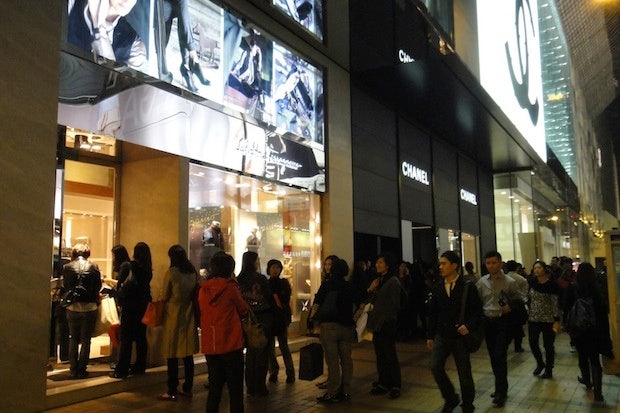
Luxury shoppers in Hong Kong. (myhsu/Flickr)
In the wake of China’s slowing luxury sales, a new Bain report predicts that North America will surpass China as the top region for luxury growth this year, a sharp turnaround for brands that have zeroed in on China growth over the past several years. However, this doesn’t mean that luxury brands can scale down their efforts to market to Chinese clients. Rather, they're going to have to step up their global initiatives, since the study also finds that the Chinese traveler is still the most important global luxury consumer.
The report on the global luxury market released yesterday predicted that worldwide sales will rise 6 percent at constant exchange rates in 2013, with 4 percent growth in North America and only 2.5 percent growth in China, bumping China to second place. This isn't the only recent study saying that North America will reign this year—a recent luxury CEO survey commissioned by luxury lifestyle publication Departures and authored by research firm Ledbury also found that brand executives were most optimistic about growth in the North America market.
The reasons for China’s move into second place include a slowing GDP, high tariffs on imported goods, a government crackdown on official corruption and extravagance, and shifting Chinese taste away from ostentatious luxury products. As a result of the diversity of these reasons, not all luxury brands are experiencing the slowdown in the same way: while the growth of low-key designers such as Bottega Veneta and lifestyle brands such as Coach has remained high in China, mega-brands such as Louis Vuitton and Gucci are striving to regain their high numbers from previous years.
However, Chinese tourists are still way ahead of the pack in terms of global luxury consumption, meaning a great deal of that North American growth is going to be driven by their purchases. The study finds that Chinese consumers represent 29 percent of all luxury consumers in 2013, and most of those purchases are made outside the mainland thanks to high tariffs on foreign luxury products. A recent report by A.T. Kearney also came to a similar conclusion, finding that 2 percent of Chinese consumers accounted for about one third of the world’s luxury consumption this year.
On a practical level, these findings mean that brands will need to globalize their strategies in marketing to the traveling Chinese customer now more than ever before. Luxury brands should focus on features such as Mandarin-speaking staff, standardized product offerings, and Chinese payment options in locations across the world if they haven’t already done so. In addition, just because China is slowing doesn’t mean its store locations are any less important—Chinese consumers are able to develop brand awareness from them at home, even if they’re buying the non-tariff goods abroad.